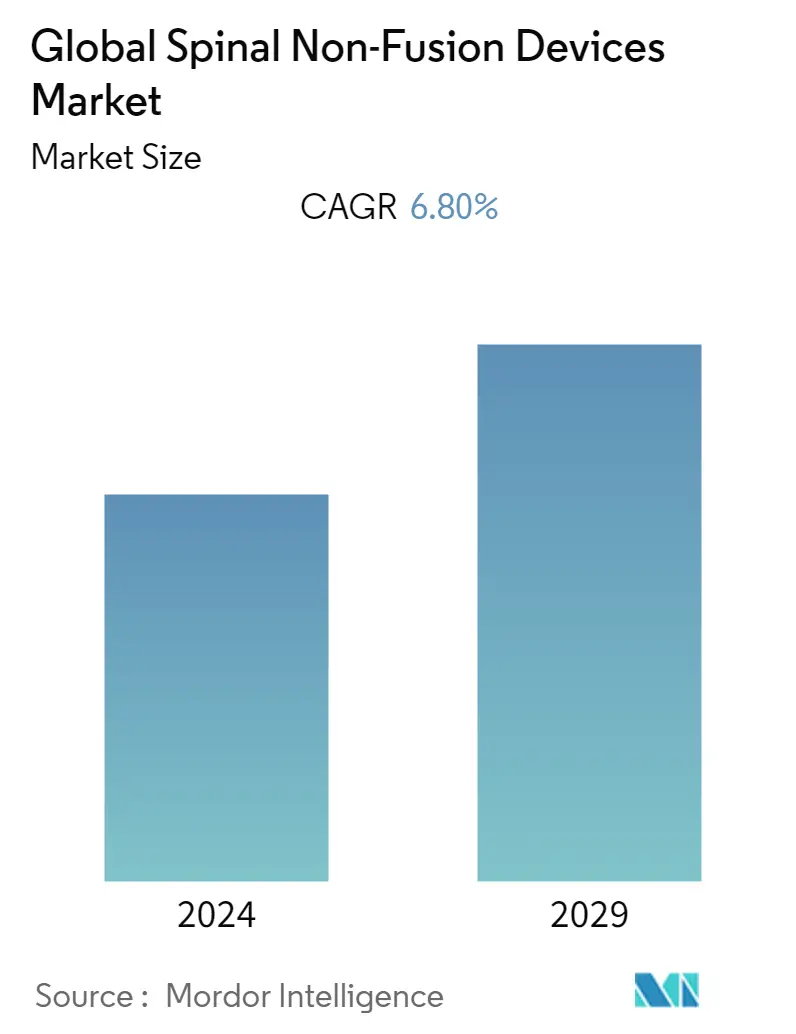Market Size of Global Spinal Non-Fusion Devices Industry

| Study Period | 2019 - 2029 |
| Base Year For Estimation | 2023 |
| CAGR | 6.80 % |
| Fastest Growing Market | Asia Pacific |
| Largest Market | North America |
| Market Concentration | Medium |
Major Players
*Disclaimer: Major Players sorted in no particular order |
Need a report that reflects how COVID-19 has impacted this market and its growth?
Spinal Non-Fusion Devices Market Analysis
The spinal non-fusion devices market is expected to register a CAGR of 6.8% over the forecast period.
The COVID-19 pandemic has significantly impacted the spinal non-fusion devices market worldwide. In addition to the effects of the disease on public health, there was also a collateral effect on the disruption and cancelation of surgical services. For instance, a research study titled "COVID-19 pandemic and elective spinal surgery cancelations - what happens to the patients?" published in PubMed, in December 2021, stated that due to the reallocation of resources to the care of COVID-19 patients, the COVID-19 pandemic resulted in a suspension of elective procedures. Following the start of elective surgeries, a considerable number of patients continued to postpone surgery, with many still waiting to be rescheduled, potentially prolonging their discomfort and impairment of function. The study concluded that over one-third of the elective spine procedures that were canceled due to COVID-19 had not been performed in the eight months since the procedures were resumed. Such instances had adverse impact on the demand for spinal surgery devices over the pandemic phase.
Furthermore, the CovidSurg Collaborative, a 120-country research initiative formed to analyze the impact of the COVID-19 pandemic on surgeries, predicted that approximately 28.4 million elective surgeries were canceled or postponed in 2020. Thus, impacting the demand for spinal surgery devices worldwide. Likewise, as per an article published in 2021 under the title, "The Impact of the COVID-19 Pandemic on Spine Surgery in Central Europe: A Questionnaire-Based Study", the COVID-19 pandemic resulted in comparable restrictive measures for spinal surgical departments in Central Europe. As per the same source, elective surgical interventions were reduced. Such incidences have reduced the use of spinal surgery devices owing to the lower number of surgeries performed. However, the market is expected to gain traction over the coming years as a result of declining COVID-19 cases and the resumption of elective surgeries.
Further, the key factors propelling the growth of this market are the increasing adoption rate of minimally invasive spinal surgeries, an upsurge in technological advancements in the spinal surgery sector, and growing incidences of obesity and degenerative spinal conditions. The companies are also engaged in the development of innovative products which is further supporting the market growth. For instance, in June 2021, a team of engineers and clinicians at the University of Cambridge developed an ultra-thin, inflatable spinal device that can be used to treat the most severe forms of pain without the need for invasive surgery. Moreover, in July 2021, NuVasive's Pulse platform for spine surgery received United States Food and Drugs Administration (US FDA) 510 (k) approval. Such developments are fueling the adoption and demand for spinal surgery devices, thereby contributing to the market's growth.
Furthermore, the increasing prevalence of obesity is also contributing to the market growth. For instance, as per the June 2021 statistics by the World Health Organization (WHO), 39 million children under the age of 5 were overweight or obese in 2020. As the obese population with a higher Body Mass Index (BMI) was more vulnerable to spine-related disorders and back pain, the demand for spinal surgeries among this age group is likely to increase soon, ultimately driving the growth of the spinal surgery devices market.
However, the stringent regulatory process for new product approvals and expensive treatment and procedures are the major factors that restrain the market's growth.
